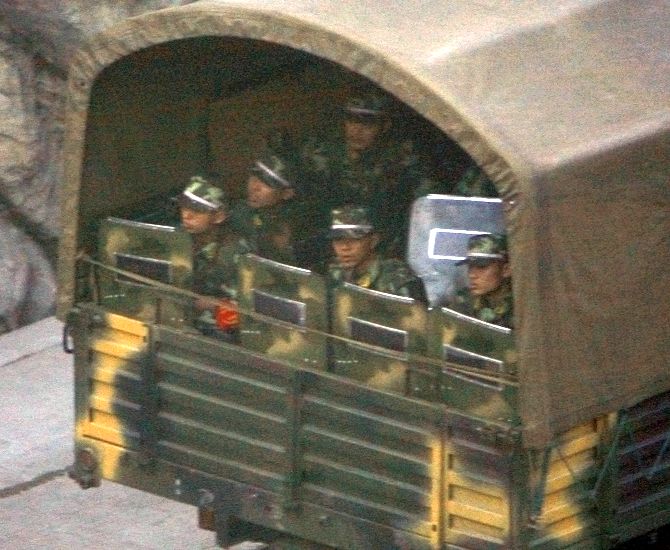The intrusions into India were likely carried out by the PLA’s better trained and equipped ‘mobile operational units’.
Ajai Shukla reports.
IMAGE: Chinese soldiers with riot shields. Photograph: David Gray/Reuters
With China’s People’s Liberation Army intruders still occupying Indian territory and large PLA reinforcements ready on the Chinese side of the Line of Actual Control, Indian military planners are calculating: How many more soldiers can the PLA quickly field if fighting were to break out?
US-based PLA expert Dennis Blasko said he estimates that around 235,000 PLA troops, including border defence personnel and the PLA’s cutting edge ‘mobile operational units’, are located in the PLA’s Western Theatre Command, which oversees the entire India-China border as well as China’s restive autonomous areas — Tibet and Xinjiang.
In March, the Belfer Center at Harvard Kennedy School also estimated ‘a total of 200,000 to 230,000 Chinese ground forces under the Western Theatre Command, including the Tibet and Xinjiang Military Districts’.
These numbers include the PLA’s lightly equipped ‘Border Defence Units’, which are permanently stationed along the border and are geared for border management and patrolling, not for full-scale combat operations.
According to the International Institute for Strategic Studies, about 16 Border Defence Regiments, with about 40,000 personnel, monitor Tibet and Xinjiang’s 5,000 kilometre border with India, Nepal and Bhutan.
These Border Defence Regiments are strung out in remote outposts all along the border to observe activity and conduct patrols between outposts by foot or by vehicle, depending on the terrain, sometimes using small drones.
Blasko says patrols are routinely carried out by squads (about eight men) or sometimes platoons (about 40). They are very lightly armed with the mission to observe and report rather than fight. These are the patrols that come into contact with Indian patrols.
Combat operations are the job of the PLA’s ‘mobile operational units’ or ‘combined arms brigades’. These are assigned to the PLA’s ‘group armies’ or placed under the Tibet and Xinjiang Military Districts.
A ‘combined arms brigade’ is one of the combat structures created in the PLA’s far-reaching reforms of 2017, and consists of 5,000 to 6,000 soldiers.
Besides light or standard infantry, the ‘combined arms brigade’ has armoured vehicles, artillery and air defence guns, engineers and other branches needed for the brigade to perform an operational task independently.
The PLA’s Western Theatre Command has two ‘group armies’ — the equivalent of corps — under it.
The 77th Group Army, headquartered in Sichuan, consists of six combined arms brigades and seven support brigades.
Of these, three combined arms brigades are based in Tibet, reducing the strength in Sichuan to about 35,000 personnel. These are located some 1,400 kilometres east of Lhasa.
The 76th Group Army, headquartered in Ningxia, consists of six combined arms brigades and six support brigades. Its 50,000 soldiers are located in Qinghai, Gansu and Ningxia, about 1,600 kilometres by train or road from Lhasa.
The command of border forces opposite India is split between the Xinjiang Military District and Tibet Military District.
In the Tibet Military District, Blasko estimates the regular army has about 50,000 soldiers, divided into three combined arms (or light mountain infantry) brigades, at least eight support brigades (SOF, artillery, air defense, army aviation, engineer and chemical defence, electronic countermeasures, motor transport), plus logistics warehouses and depots.
Most of these are stationed around Lhasa, roughly 1,400 to 1,600 kilometres away from Ladakh.
The closest to Ladakh is the Xinjiang Military District, which consists of four infantry divisions, and SOF, artillery, air defence, army aviation, intelligence and reconnaissance brigades, and additional support unit. Its 50,000-60,000 personnel are widely dispersed.
The closest formation to Ladakh — some 600 kilometres by road from Galwan — is the 6th Mechanised Infantry Division in Southern Xinjiang, with about 10,000 personnel and a large number of tanks.
The Xinjiang Military District commander, Major General Liu Lin, has been participating in the senior military commanders’s dialogue with the commander of India’s 14 Corps, Lieutenant General Harinder Singh. Major General Liu probably oversees the border units in Aksai Chin.
Blasko estimates the PLA has probably deployed five-six ‘combined arms brigades’ to the Depsang, Galwan, Hot Spring, Pangong Tso, Demchok and Chumar sectors.
In each of these sectors, the PLA would have pushed one or two battalions (500 men each) across the LAC, while retaining another two or three battalions, as well as the supporting arms and logistics elements, on China’s side of the LAC.
“It would be very difficult for a normal border defence regiment to concentrate as much force at a single location as reported at the build-ups at Galwan, Hot Spring, or Pangong Lake, while still continuing to monitor its entire area of responsibility,” says Blasko, concluding that the intrusions into India were probably carried out by the PLA’s better trained and equipped ‘mobile operational units’.
The commercial satellite imagery that has been released for the Galwan and Pangong Lake areas, adds Blasko, also suggests the deployment of the PLA’s ‘mobile operational units’.

